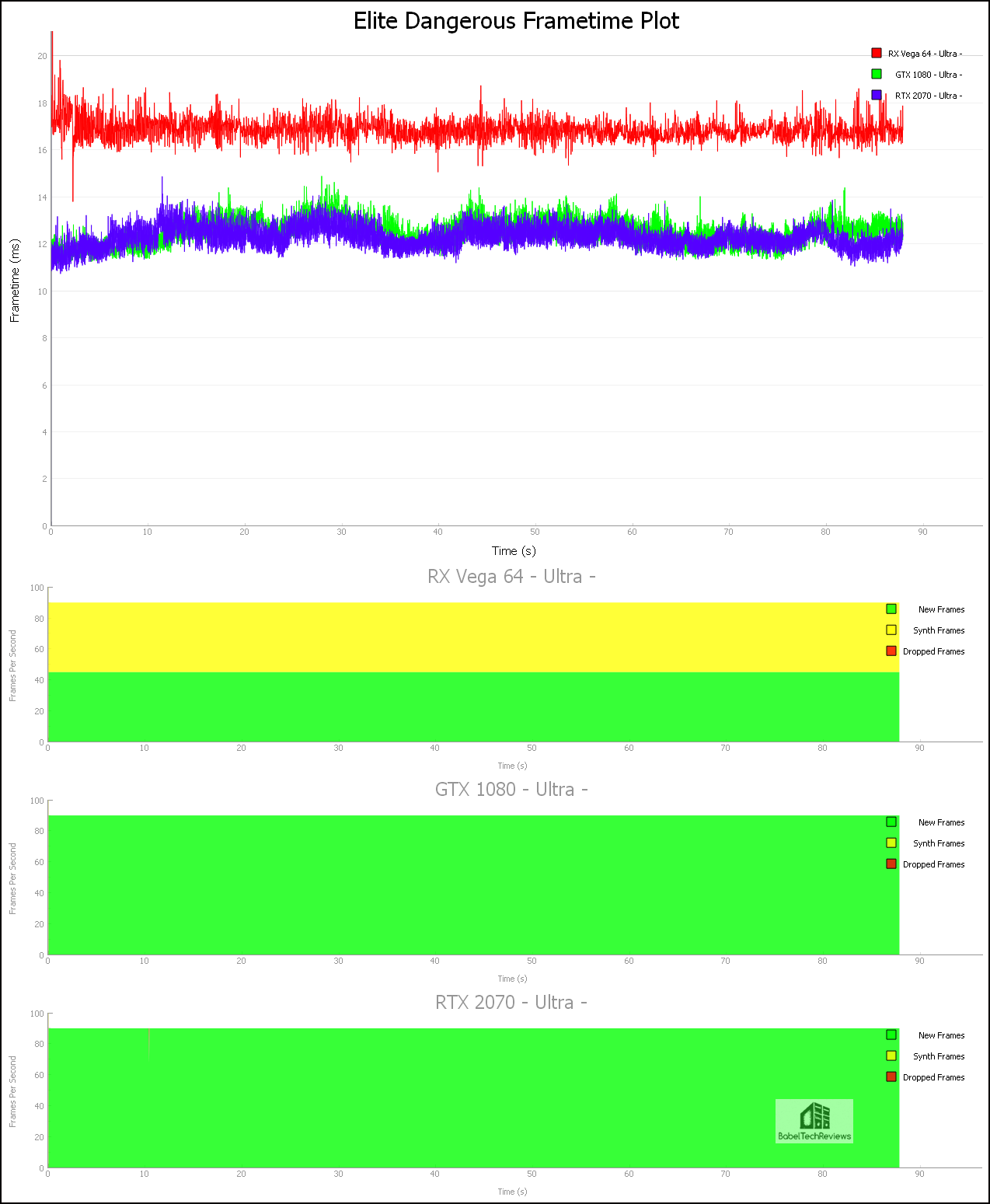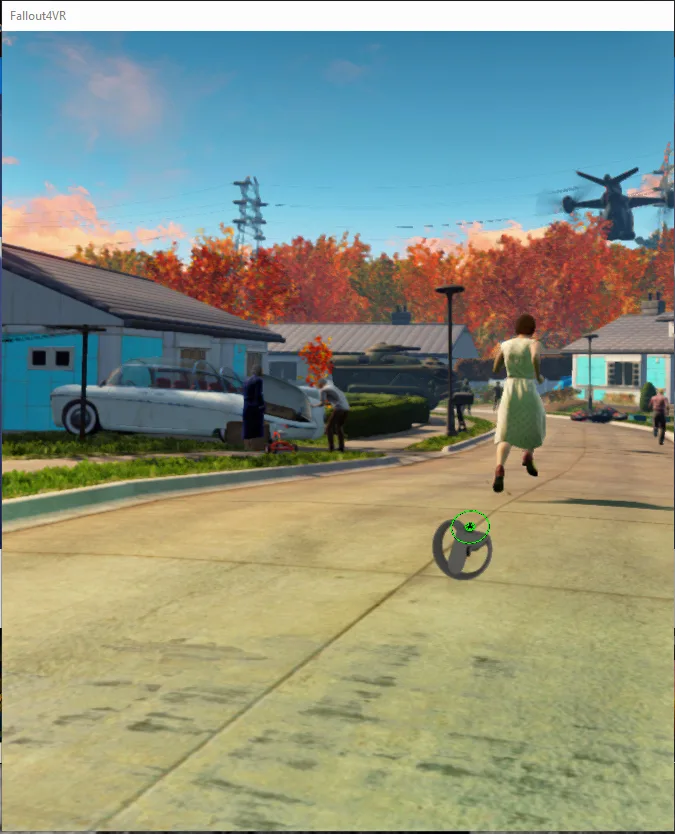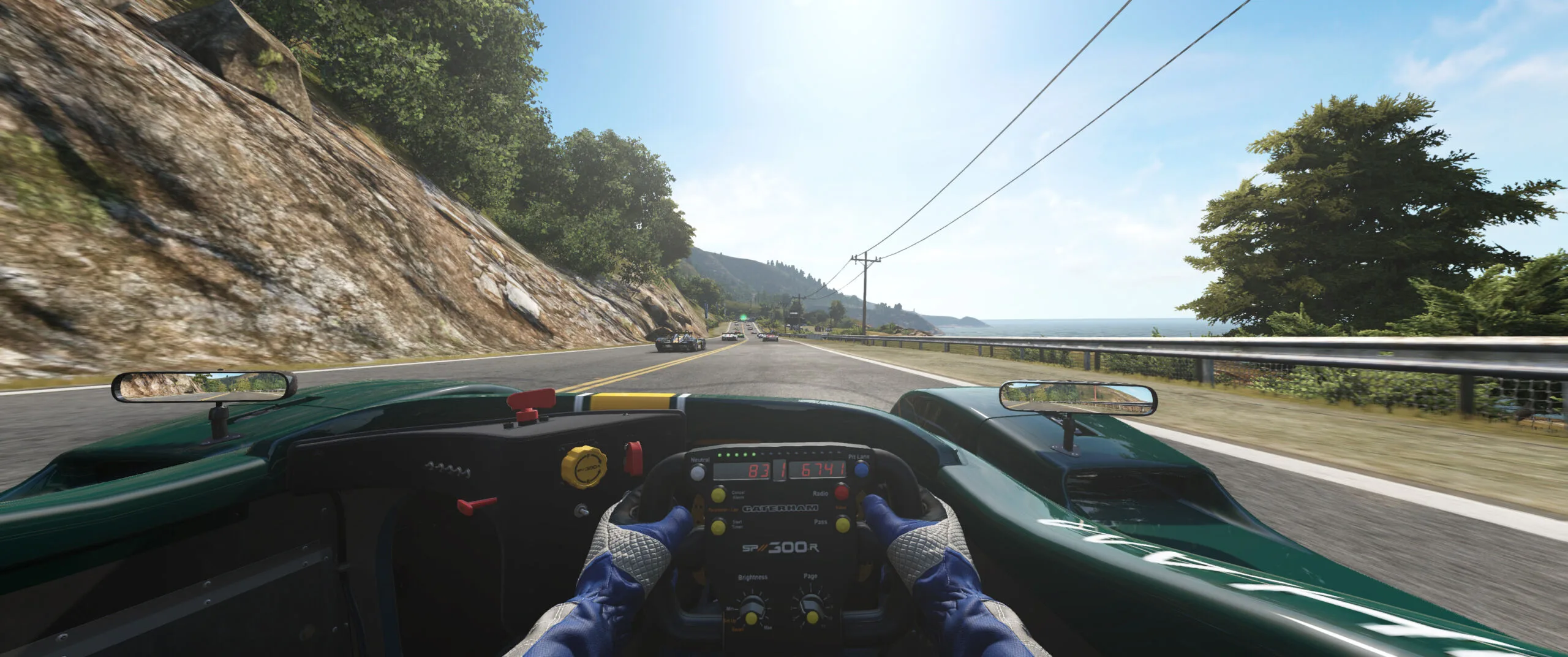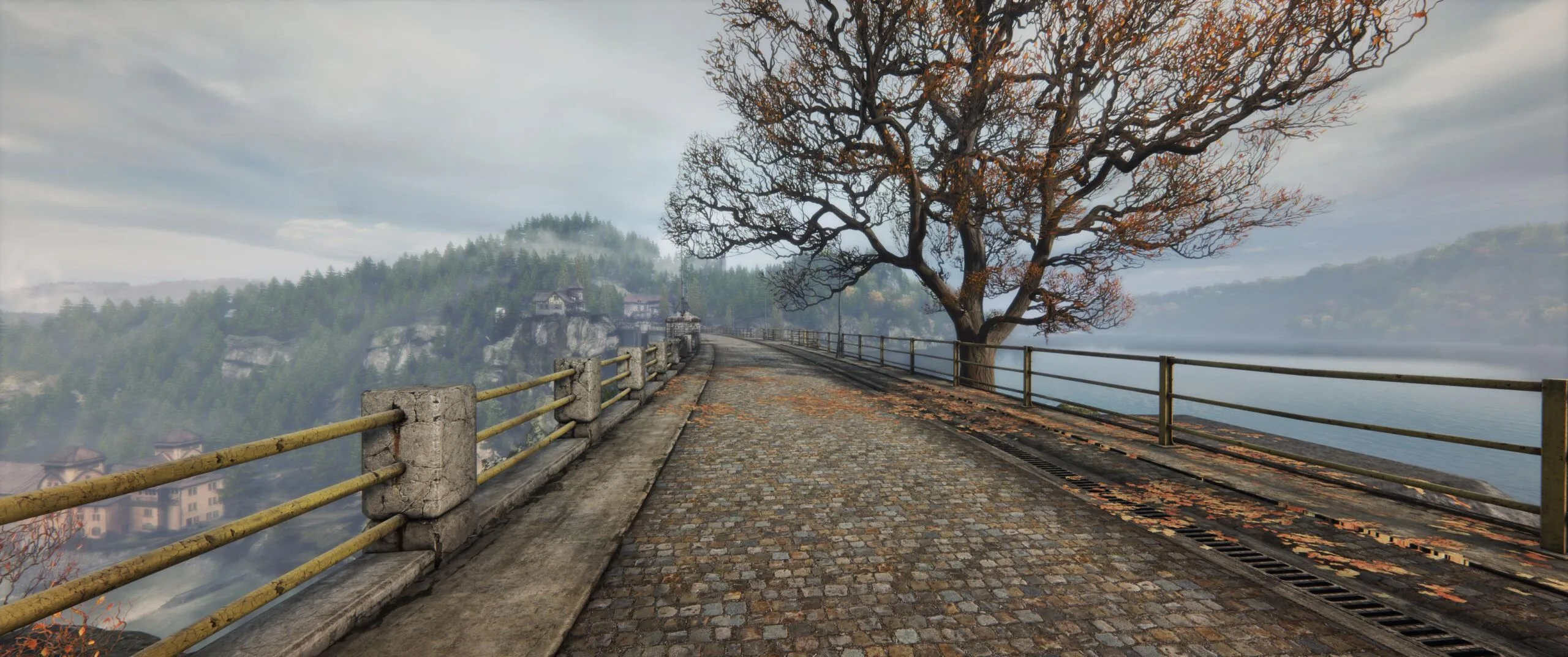VR Wars: Turing vs. Pascal vs. GCN 5 – the RTX 2070 vs. the GTX 1080 vs. the liquid-cooled Vega 64
It has been nearly two years since BTR compared the GTX 1080 versus the RX Vega 64 in VR, and this time we have added the RTX 2070. This is a follow-up to our April VR evaluation where we saw the Turing RTX 2080 move ahead of the Pascal GTX 1080 Ti in VR performance. We now present an eleven-game upper-midrange video card VR performance face-off measuring frametimes and unconstrained performance using FCAT VR.
Since we posted our original review over two and one-half years ago, we have benchmarked up to 20 VR games for our follow-up reviews over the past thirty months. We have also compared FCAT VR with our own video benchmarks using a camera to capture images directly from the Rift’s lens. For BTR’s VR testing methodology, please refer to this evaluation.
We currently benchmark eleven Oculus Rift VR games at maxed-out settings using the liquid-Cooled RX Vega 64 (LC) versus the GTX 1080 Founders Edition (FE) and versus the RTX 2070 Founders Edition (FE). BTR’s testing platform is an Intel Core i7-8700K at 4.8GHz, an EVGA Z370 FTW motherboard and 16 GB of T-Force XTREEM DDR4 at 3866MHz on Windows 10 64-bit Home Edition. Here are the eleven VR games that we benchmark:
- Batman VR
- Chronos
- DiRT: Rally
- Elite Dangerous
- Fallout 4
- Hellblade: Sennua’s Sacrifice
- Obduction
- Project CARS 2
- Robinson: The Journey
- Skyrim
- The Vanishing of Ethan Carter
Until FCAT VR was released there was no universally acknowledged way to accurately benchmark Oculus Rift games. To compound the difficulties of benchmarking these games, there are additional complexities because of the way it uses a type of frame reprojection called asynchronous space warp (ASW) to keep framerates steady at either 90 FPS or at 45 FPS.
It is important to be aware of VR performance since poorly delivered frames will actually make a VR experience quite unpleasant and a gamer may even become VR sick. It is also very important to understand how one can accurately benchmark VR as explained here. Before we benchmark our eleven VR games, take a look at our Test Configuration.
Test Configuration – Hardware
- Intel Core i7-8700K (HyperThreading and Turbo boost is on to 4.8 GHz for all cores; Coffee Lake DX11 CPU graphics).
- EVGA Z370 FTW motherboard (Intel Z370 chipset, latest BIOS, PCIe 3.0/3.1 specification, CrossFire/SLI 8x+8x), supplied by EVGA
- T-Force XTREEM 16GB DDR4 (2×8 GB, dual channel at 3866MHz), supplied by Team Group
- RTX 2070 8 GB Founders Edition, stock FE clocks, on loan from NVIDIA
- GTX 1080 8GB Founders Edition, stock FE clocks, on loan from NVIDIA
- Liquid-Cooled RX Vega 64, 8GB at liquid-cooled clocks
- 2 x 480GB Team Group SSDs – 1 for Radeon and 1 for GeForce
- 1.92 TB San Disk enterprise class SSD
- 2 TB Micron 1100 enterprise class SSD
- Seasonic 850W Gold Focus power supply unit
- EVGA CLC 280mm CPU water cooler, supplied by EVGA
- EVGA Nu Audio stereo PCIe sound card, supplied by EVGA
- Edifier R1280T active desktop speakers
- EVGA DG-77, mid-tower case supplied by EVGA
- Monoprice Crystal Pro 4K
- Oculus Rift
Test Configuration – Software
- Nvidia’s Game Ready 430.86 WHQL drivers. See Control Panel image below.
- Adrenalin Software Edition 19.6.2
- Unconstrained framerate results show average frame rates in bold including dropped and synthetic frames shown on the chart next to the averages in a smaller italics font.
- Highest quality sound (stereo) used in all games.
- Windows 10 64-bit Home edition v1903.
- Latest DirectX
- All 11 VR games are patched to their latest versions at time of publication.
- MSI Afterburner latest Beta
- Wattman
- FCAT-VR Capture v0.9.3202.0 UAC
- FCAT-VR Beta 17
11 VR Game benchmark suite & 2 synthetic tests
Synthetic
- VRMark Cyan Room
- Unigine Superposition VR Benchmark
Oculus Rift VR Games
- Batman VR
- Chronos
- DiRT: Rally
- Elite Dangerous
- Fallout 4
- Hellblade: Senua’s Sacrifice
- Obduction
- Project CARS 2
- Robinson: The Journey
- Skyrim
- The Vanishing of Ethan Carter
The Unreal 4 engine is probably one of the two most popular engines for VR development, and five of our games use it. The Creation engine is used for two games, while the Ego, COBRA, Cryengine, and Madness engines are each represented by one game. All of the engines are identified in each of the following game’s descriptions.
We used MSI’s Afterburner to set both GeForce cards’ highest Power and Temperature targets just as we used Wattman similarly for the liquid-cooled RX Vega 64. By setting the Power Limits and Temperature limits to maximum for each card, they do not throttle, but they can each reach and maintain their individual maximum clocks.
Let’s individually look at our eleven VR games’ performance plus two synthetic benches using FCAT-VR.
Synthetic Benchmarks
We don’t give a lot of credence to synthetic benchmarks as they only are useful for the engines they are designed with and they have little to do with actual performance for any games. However, here are Unigine’s Superposition VR benchmark and VRMark’s Cyan benchmark results.
If we go by these synthetic tests, the RTX 2070 should be significantly faster in VR than the GTX 1080 which in turn should also be bested by the liquid-cooled Vega 64. But let’s see if this holds true for our eleven VR test games. First up, Batman Arkham VR.
Batman Arkham VR
Batman Arkham VR is an unusual game that immerses you into Batman’s world but really doesn’t involve fighting. It is a short game using the Unreal Engine that uses a lot of interactivity with an emphasis on detective work and puzzle solving. Although it is an older title, it still has good visuals.
Batman Arkham VR has very few adjustable settings so we benchmark at its full resolution and with 100% pixel density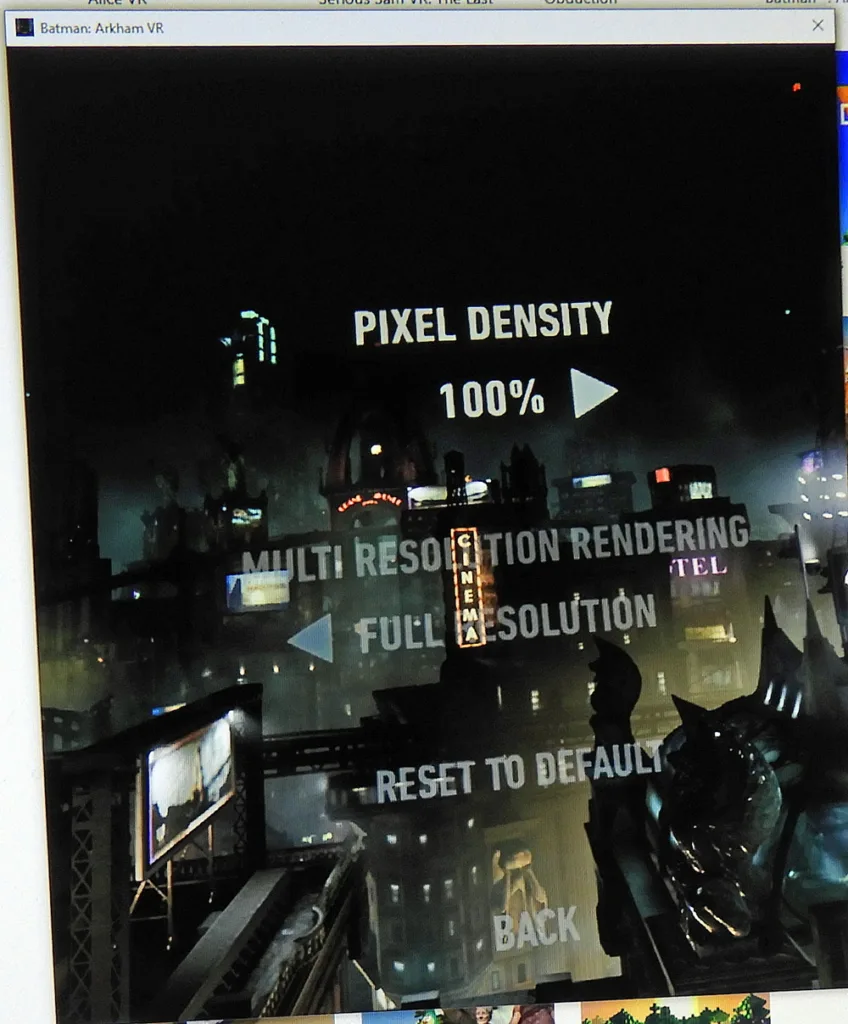
Here are the performance results of our three competing cards compared using the FCAT-VR generated chart.
The unconstrained framerate of the RTX 2070 is 176.9 FPS with 1 dropped frame, and it is faster than the GTX 1080 at 166.8 FPS with no dropped frames. The LC Vega 64 follows with 127.7 FPS with 4 dropped frames. None of our cards need to resort to generating synthetic frames using ASW in this older VR game.
Chronos
Chronos is a Rift launch title with graphics options that are still good for GPU testing. It is an very well-made 3rd-person view RPG, and it is also very difficult. It offers at least 15 hours of play with many puzzles to solve as well as requiring the player to be good with combat timing. 
We picked Epic which is the highest settings for each option.

Here is the FCAT-VR generated chart for Chronos.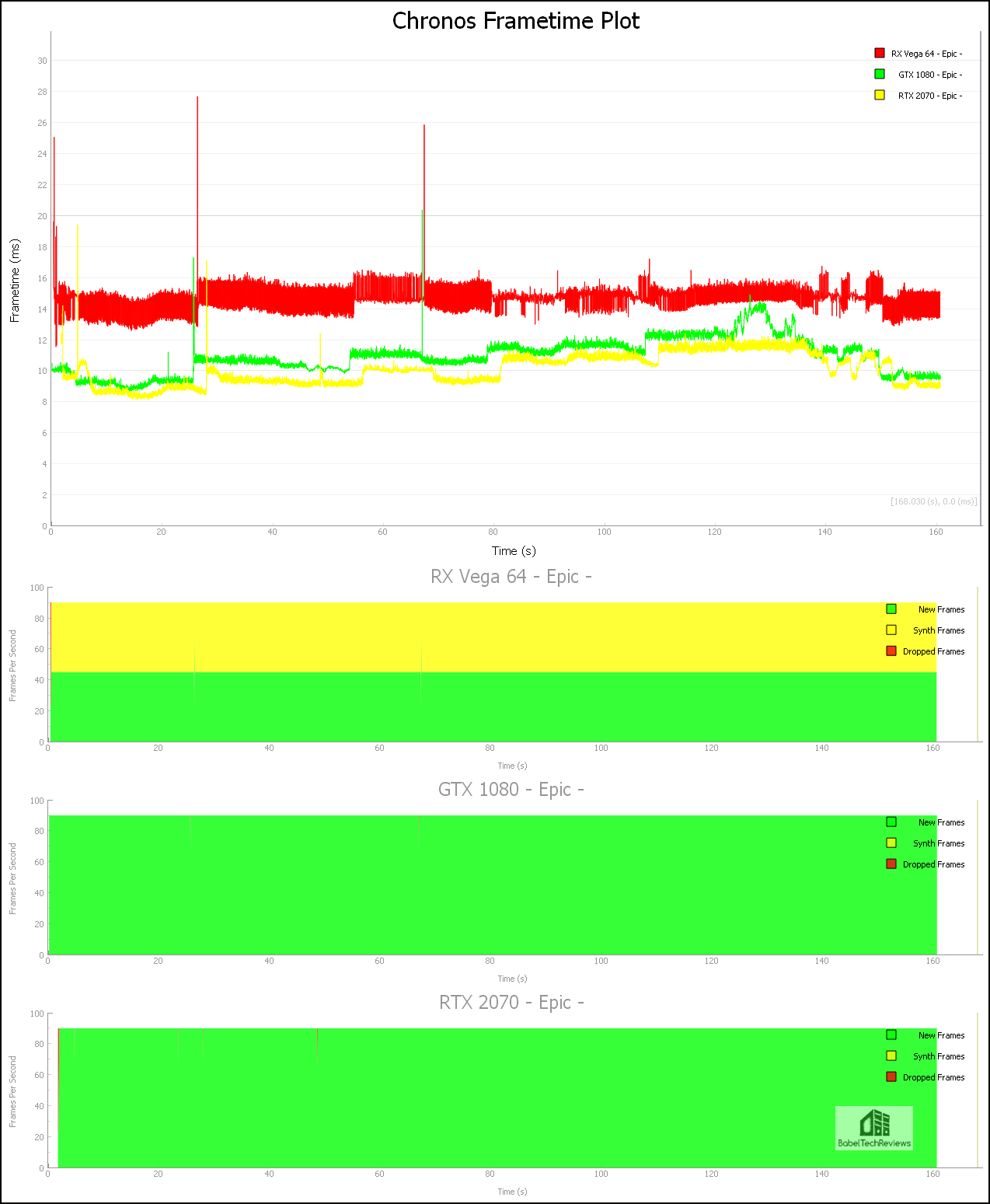 The RTX 2070 leads with unconstrained 99.4 FPS with 17 dropped frames, the GTX 1080 manages 91.6 FPS with 2 dropped frames, but the LC Vega 64 can only manage 68.3 FPS with 9 dropped while 50% of its frames are synthesized. We would recommend lowering setting for the Vega 64 to High or lower.
The RTX 2070 leads with unconstrained 99.4 FPS with 17 dropped frames, the GTX 1080 manages 91.6 FPS with 2 dropped frames, but the LC Vega 64 can only manage 68.3 FPS with 9 dropped while 50% of its frames are synthesized. We would recommend lowering setting for the Vega 64 to High or lower.
Let’s check out DiRT: Rally next.
DiRT: Rally
DiRT: Rally is built on the Ego Engine. It features a built-in benchmark that is very repeatable. If the framerate drops below 90 FPS, the Test Summary of the built-in benchmark accurately shows the minimum as 45 FPS (with ASW reprojection) but it does not display unconstrained FPS or frametimes so we use FCAT-VR. DiRT: Rally is a fun and demanding game for VR that requires the player to really learn its challenging road conditions. Best of all, DiRT: Rally has a lot of individual settings that may be customized although we benchmarked using the stock “Ultra” preset.
DiRT: Rally is a fun and demanding game for VR that requires the player to really learn its challenging road conditions. Best of all, DiRT: Rally has a lot of individual settings that may be customized although we benchmarked using the stock “Ultra” preset.
Here is the DiRT: Rally benchmark as run by our 3 test cards and charted by FCAT-VR.
The RTX 2070 manages 105.7 unconstrained frames per second with 21 dropped frames while the GTX 1080 delivers 98.5 FPS with 19 dropped frames. Although neither card generates any synthetic frames, the LC RX Vega 64 manages 79.3 FPS, 5 frames are dropped, and 30% of its frames are synthetic.
Elite Dangerous
Elite Dangerous is a very popular space sim built using the COBRA engine with multiple options available. It is difficult to find a repeatable and demanding benchmark outside of the training missions.

A player will spend a lot of time piloting a space cruiser looking at a skybox of nearly empty space as they explore the universe completing a multitude of tasks. Elite Dangerous is also co-op and multiplayer, and you need to be connected to the Internet to play. It it patched and updated often and it has a very dedicated following of players.
We picked the default Ultra setting and maxed out our FoV. Here are the frametimes comparing the RX Vega 64 versus the GTX 1080 and versus the RTX 2070.
The RTX 2070 delivers 81.5 unconstrained frames per second with 1 dropped frame edging out the GTX 1080 with 80.0 FPS with no dropped frames. Surprisingly, no synthetic frames were generated although the RX Vega 64 LC only managed 59.3 FPS with no dropped frames but with 50% synthetic frames.
Let’s check out another demanding game, Fallout 4.
Fallout 4 VR
Fallout 4 is probably one of our three most demanding titles and it is an impressive game visually using the Creation Engine. It has been somewhat optimized for the Oculus Rift and the controls work decently with it now. We benchmark at its highest settings and with TAA.
Here is the frametime plot for Fallout 4 once again comparing the RTX 2070 versus the GTX 1080 and versus the Vega 64 LC.
In Fallout 4, the GTX 1080 delivers 53.3 unconstrained frames per second with 2820 dropped frames and no synthetic frames, while the RTX 2070 delivers 63.4 FPS with 166 dropped frames and 7% synthetic frames. The difference is that ASW did not kick in for the GTX 1080 giving a rather poor VR gaming experience as about half of the frames were dropped. We would recommend going into the Oculus Rift Diagostics, enabling the DeBug Tool, and forcing ASW on for the GTX 1080 if you experience poor framerate delivery. The Vega 64 LC delivered 61.8 unconstrained FPS with 279 dropped frames and generated 20% synthetic frames.
Next we look at Hellblade: Senua’s Sacrifice.
Hellblade: Senua’s Sacrifice
Hellblade: Senua’s Sacrifice is our newest benchmark and it is a very impressive game visually using the Unreal 4 engine. It is an extremely dark and disturbing game that is far more intense in VR than playing the pancake version. We benchmark at the Very High settings and with TAA.
Here is the frametime plot for Hellblade: Senua’s Sacrifice once again comparing the GTX 1080 performance with the RTX 2070 and with the Vega 64 LC.
In Hellblade: Senua’s Sacrifice, the GTX 1080 delivers 99.5 unconstrained frames per second with 27 dropped frames, while the RTX 2070 delivers 109.5 FPS with 25 dropped frames. The RX Vega 64 LC manages 82.5 unconstrained FPS with 1 dropped frame but 34% of its frames are synthetic.
Next we will check out another very demanding VR game, Obduction.
Obduction
Obduction is an adventure video game developed by Cyan Worlds using the Unreal 4 engine. Obduction is considered the spiritual successor to Myst and Riven. A player finds himself in a oddly familiar alien world that he must explore to return home, and there is a big emphasis on puzzle solving which gets more and more difficult as the player progresses.

Here is the frametime plot comparing the RX Vega 64 LC with the GTX 1080 with the RTX 2070.
The GTX 1080 delivers 70.9 unconstrained frames per second with 24 dropped frames generating 16% synthetic frames, while the RTX 2070 delivers 75.1 FPS with 45 dropped frames but with 7% synthetic frames generated. The RX Vega 64 LC can only manage 53.7 FPS with no dropped frames, but 50% of the frames are synthesized.
Next we will check out another demanding VR game, Project CARS 2.
Project CARS 2
One has to experience Project CARS 2 as a player to appreciate it, and there is absolutely no way to convey the incredible sense of immersion that comes from playing it in VR using a wheel and pedals. It uses the in-house Madness engine and its physics implementation is outstanding.
Project CARS 2 is a huge game that a player may spend hundreds of hours with, and there is a learning curve as one cannot just jump into a supercar and expect to immediately race successfully. Project CARS 2 is a sim, and although it can be dumbed-down into an arcade-style racer, it is best played with a racing wheel and pedals.
Project CARS 2 offers many performance options and settings, and we prefer playing with SMAA Ultra which appears to offer a bit of temporal anti-aliasing.

There are no overall default “ultra”, “high”, “medium”, or “low” settings, so we picked the SMAA Ultra pre-set and we used maximum settings – except for Motion Blur which looked best to us on Low. Other individual setting were moved to their highest settings including Pit Crew Detail to “All” and “Yes” for Enhanced Mirrors. For VR we set our mirrored desktop resolution to a windowed 1024×720.
Since our chosen settings are demanding, Project CARS 2 makes good use of the Oculus Asynchronous Space Warp (ASW) feature so that a card delivering less than 90 FPS will intelligently reproject every other frame and will still be playable without causing VR sickness. We would recommend, however, lowering grass and reflections to maximize framerate delivery outside of benchmarking this game.
Here are the results of our FCAT-VR benching.
The RTX 2070 delivers 70.9 unconstrained FPS, 1 dropped frame and 42% synthetic frames generated, while the GTX 1080 manages 68.7 fps and 1 dropped frames with 16% synthetic frames generated. The RX Vega 64 LC delivers 58.7 FPS with no dropped frames although half of its frames are synthesized.
Let’s benchmark Robinson: The Journey.
Robinson: The Journey
Robinson: The Journey is first person adventure/puzzle game developed by Crytek using the Cryengine. Just like with Crytek’s PC games, the visuals are among the very best to be found in any VR game.
For us, Crytek’s Robinson: The Journey was a blast to play in VR with a start to finish in about 6 hours. It’s probably Crytek’s best story of any game they have made. You even get a very cure baby T-Rex as a pet who likes to play hide and seek, roars on command to frighten and help move huge vegetation-eating dinosaurs.

We benchmarked the highest settings as below (but chose 1.0X for the resolution setting).
Here is the frametime plot of our competing three video cards:
The GTX 1080 delivers 147.2 unconstrained frames per second with 2 dropped frames, while the RTX 2070 delivers 165.0 FPS also with 2 dropped frames. The RX Vega 64 delivers 127.9 FPS with 17 dropped frames. No synthetic frames were needed to be generated by any of our three cards.
Let’s benchmark Skyrim VR.
Skyrim VR
Skyrim VR is an awesome game that this editor has played for over 40 hours in VR just to complete the main quest. The immersion a player experiences in this game is far superior to anything the pancake version can deliver. Skyrim VR is an older game that is not as demanding as many of the newer VR games so its performance is still very good on maxed-out settings using its Creation engine. But there are visual mods available to make the game look even more incredible in VR, and they can be quite demanding.
We benchmarked Skyrim VR using its highest settings, but we left the resolution at 100%.
The RTX 2070 delivers 146.0 unconstrained frames per second with 13 dropped frames, while the GTX 1080 delivers 130.5 FPS but with 10 dropped frames. The RX Vega 64 LC delivered 97.8 FPS with 18 dropped frames. No synthetic frames were needed to be generated by any of our cards. We would recommend increasing the resolution multiplier as far as a player’s card can handle without needing to generate synthetic frames while playing the vanilla Skyrim VR game.
The Vanishing of Ethan Carter
The Vanishing of Ethan Carter is built on the Unreal 4 engine and it boasts amazing visuals. It is considered by some to be a “walking simulator”, but it is also an excellent detective game with great puzzles. It doesn’t hold your hand, nor is it linear, but it allows a player to explore freely in a mostly large open world.
Although The Vanishing of Ethan Carter is one of the most impressive games visually, there are issues with its free locomotion implementation that can make some of the more VR-hardened players, VR sick. But we completed the game and loved its story.
There are just a few in-game graphics options available, so we picked 100% resolution with TAA.
The GTX 1080 delivers 171.7 unconstrained frames per second with 8 dropped frames, making it faster than the RTX 2070 with 163.9 FPS with 9 dropped frames. The RX Vega 64 LC delivers 121.2 FPS with 10 dropped frames. No synthetic frames were needed to be generated by any of our three tested cards.
If there is performance headroom, we recommend increasing the resolution multiplier as far as a player’s card can handle without needing to generate synthetic frames. The Vanishing of Ethan Carter is the last of our eleven tested games, so let’s look at the summary charts.
Unconstrained FPS, dropped frames, and synthetic frames
In this chart, we summarize the overall Unconstrained Framerate chart summing up our eleven test games across all three competing cards. The Unconstrained Framerate is given by bold text, followed by the dropped frames (d), and the percentage of synthetic frames (s) in italics.
Let’s check out our conclusion.
Conclusion
Just as the RTX 2080 is overall faster than the GTX 1080 Ti in VR, the RTX 2070 is also overall faster than the GTX 1080 except for one game, The Vanishing of Ethan Carter. In the eleven games we tested, the liquid-cooled RX Vega 64 falls well behind the GTX 2070, and it only beats the GTX 1080 in one game – Fallout 4. In Fallout 4, the GTX 1080 failed to use ASW reprojection and dropped frames instead. We would recommend forcing on ASW if you have this issue with any game.
Although the RX Vega 64 liquid-cooled edition is in the same class as the GTX 1080 and the RTX 2070, it falls behind both of these cards in VR performance. The two VR synthetic benches that we use do not predict real-world VR performance.
We will continue our VR benchmarking after the RX 5700 XT launches on July 7. We want to see if RDNA is a better architecture for playing VR games than GCN 5, and how it compares with Turing and Pascal cards.
Feel free to comment on this review in the comments section below, and also let us know which games you would like us to add to our VR game benchmarking suite. BTR has more than 25 VR games available. In the meantime, BTR’s review queue recently has grown significantly, and we will bring you more new product reviews shortly.
Happy VR gaming!




